Physical Address
304 North Cardinal St.
Dorchester Center, MA 02124
The hand is a primary means of communication, aesthetics, emotion, and sexuality. It exists at the core of our humanity. Particularly in the modern age of digital communication, the inability to interface with the digital world via hands is socially and intellectually isolating. Hands are injured in 80% of severe burns and are a primary American Burn Association referral criterion. Loss of hand function from burn injury frequently limits the patient's ability to work and requires evaluation for long-term disability, as discussed in Chapter 63 . Functional recovery of the burned hand relies on quick and effective intervention by an experienced burn center.
Successful restoration of hand function after burn injury begins with first aid, continues through acute care and occupational therapy (OT), and is augmented with reconstructive surgery. A careful history should be taken including the nature of the injury, but also of the patient's hand dominance, occupation, and special hand uses, such as playing a musical instrument.
Initial treatment is directed to prevent both further injury and conversion of the burn penumbra. First, the burning process must be stopped by removing the patient from the heat source and irrigating away any inciting chemicals. Historically, icing the burn had been advocated; however, in modern burn care, maintaining the wound warm is now standard, and ice should be avoided. Blisters should be débrided both to allow assessment of the underlying burned dermis as well as to remove the cytotoxic mediators elaborated in the blister fluid, which can deepen the burn injury.
The burn should be staged for depth at physical examination, and the patient should have an initial assessment of sensation, motor function, skeletal stability, and circulation ( Fig. 54.1 ). The thin dorsal skin can easily suffer a third- or fourth-degree injury, whereas the thick glabrous palmar skin can often heal from even an apparently deep injury. Initial assessment is aimed at gross and limb-threatening injuries. Distracting injuries, pain, and fear can prevent an effective assessment of less obvious injuries, so patients should be followed up and reassessed.
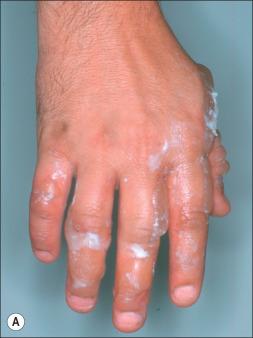
Careful and repeated assessments must be made for compromised perfusion due to compartment syndromes and circumferential eschar constriction. These processes are limb threatening, and a high index of suspicion and prompt response must be maintained. Edema resulting from burn injury and burn resuscitation can cause a delayed appearance of compartment syndrome and eschar compression. Wound edema control is best accomplished with elevation. As discussed in Chapter 8 , lymph pressures are typically in the 1–2 cm H 2 O range, and this gradient can often be overcome with elevation by suspending the hand 50–100 cm above the phlebostatic axis, thereby creating a sufficient pressure gradient driving lymphatic drainage. Wounds should be dressed in a manner such that the burned hands can be monitored for neurovascular embarrassment and progression of the burned wounds (see Box 54.1 ).
Evaluate burn and débride blisters
Decompression of compartment syndromes and eschar constrictions
Early therapy and splinting
Early excision and grafting
Early and aggressive range of motion (ROM) with occupational therapy
Secondary reconstruction of deformities
The goals of acute management of hand burns include maintaining perfusion with resuscitation, neurovascular protection through the release of eschar compression and compartment syndromes, removal of necrotic burned tissue, early grafting, and early ROM. Resuscitation and hemodynamic support are critical because the heart is the organ that perfuses the hands. Should eschar compression or compartment syndrome develop, prompt decompression is critical for limb salvage. Clinical examination is usually sufficient to diagnose eschar compressions and compartment syndromes, including paresthesias, pain, passive resistance to extension, and loss of capillary refill in the nail beds.
Escharotomies are the mainstay of decompression in burn care. Incisions are made over the medial and lateral midaxial lines through the skin down to the fascia. The line of release extends both caudad and cephalad beyond the margin of tissue swelling to ensure complete release. Incisions on fingers are made along the midlateral line just dorsal to the digital neurovascular bundle between Grayson's and Cleland's ligaments. Releasing incisions may be extended into the web spaces and to the dorsal surface of the hand to ensure the integrity of vascular supplies to the intrinsic musculatures of the hand. Many centers promote routine performance of escharotomies on both sides of fingers, and we advocate this approach. In a randomized control trial (RCT), a threefold increase in finger salvage was found with extended digital escharotomies. Escharotomies should be carried out liberally because all full-thickness burns will eventually require excision and grafting, including resection of the escharotomy incisions, as seen in Fig. 54.2D, E .
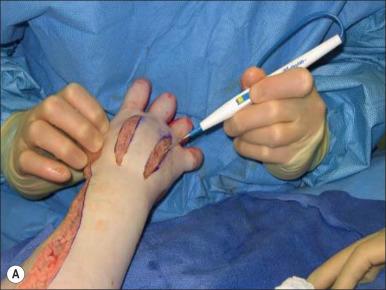
Deep hand and arm burns may be insufficiently decompressed with escharotomies alone; release of fascial compartments will be required. Incisional releases may be carried out involving the forearm muscle compartment and the carpal tunnel, as well as Guyon's canal ( Fig. 54.2 ). The intrinsic muscles of the hand are particularly susceptible to elevated compartment pressures. These muscles infarct and contract, leading to an intrinsic-minus (claw) hand, discussed later. As such, care should be taken to release the interosseous compartments dorsally, the thenar and hypothenar compartments, and the palmar spaces as shown in Fig. 54.2C . The carpal tunnel and Guyon's canal should routinely be released as part of treatment of compartment syndromes of the hand.
The next goal of therapy is management of the skin injury. Partial-thickness burns to the dorsum of the hand are effectively treated with local care, skin substitutes, and immediate motion. If minimal superficial eschar is present, débridement can be achieved either operatively or with an enzymatic agent such as collagenase. Standard skin substitutes include homograft, xenograft, and ammonic membrane, which provide a durable covering, a wound matrix, growth factors to stimulate wound healing, and minimize chronic wound granulation tissue formation. In recent decades engineered skin substitutes (Integra, TransCyte, Hyalomatrix) provide a similar skin substitution covering and matrix in an acellular manner further discussed in Chapter 15 . Other synthetic dressing materials such as nylon mesh with collagen matrix (Biobrane), polylactic acid (Suprathel), and silver ion-containing nonadherent long-term coverings (Mepilex or Acticoat) are used functionally as skin substitutes. Collectively these materials function as skin substitutes, remaining in place, protecting the wound, providing a wound matrix, and allowing reepithelialization. However aggressive care and use of skin substitutes is advised to minimize scarring and fibrosis and maximize long-term hand function. Thermoplastic custom hand splints applied immediately play an important role in maintaining hand position while at rest ( Fig. 54.3 ). Immediate ROM, however, is the most important intervention to maintain hand function. In cases where the wound is not superficial, delayed, or “conservative: burn wound treatment inevitably leads to delays, which can result in a poor outcome for the patient. Early removal of all eschar is at the core of modern burn care. In the setting of large burn wounds, definitive grafting of the hands may need to be delayed due to limitations of available grafts; hand wounds then need to be temporized with cadaveric skin. However grafting of the hands should be a high-priority limb-saving treatment, even in extensive burn injuries.
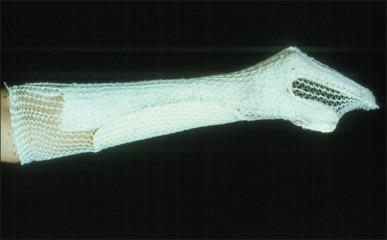
Deep burns to the dorsum of the hand are common because the skin is thin and the dorsum is exposed to injury in the protective reflex. Additionally, there is very little subcutaneous tissue so the extensor mechanism is susceptible to fourth-degree injury, particularly at the proximal interphalangeal (PIP) joint. The use of a split-thickness sheet skin graft is the preferred covering for the dorsum of the hand, providing the best scars and color match, although 1 : 1 meshing has similar outcomes. The means of securing the graft, splinting, and the timing of therapy are areas of continuing controversy. Many groups now secure grafts with fibrin sealant or sutures and begin gentle active ROM in the first postoperative day. Other groups continue to immobilize fingers in the intrinsic-plus position with K-wires for up to 6 weeks while reporting no permanent loss of ROM or articular surface damage. Still other groups advocate immobilization of the hand during engraftment with splints for short periods of time. Finally some continue to argue for grafting the dorsum in the fist position because this increases the total skin length by 20% and mitigates some of the risk of extension contracture because split-thickness skin grafts (STSG) are known to contract up to 30–50% of the total graft area. While there are data to support all of these grafting and splinting protocols, the primary goal is to begin hand therapy as soon as possible. In our experience, fibrin glues help achieve this goal effectively with initiation of motion on the first postoperative day ( Fig. 54.4 ).
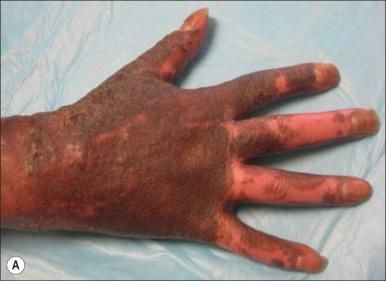
In cases where the paratenon of the extensor mechanism is compromised, skin grafts may not take well. In these cases the options are to allow granulation tissue to form on the tendons and cover with a skin graft, cover the tendons with an artificial dermal template and delayed skin grafting, or to use immediate flap coverage. Permitting the extensor mechanism to granulate with delayed skin grafting can compromise long-term hand function as the tendon becomes entrapped in scar. Such delayed treatments, however, become the treatment of choice in the setting where large burns and their threat to life are more pressing treatment priorities. Artificial dermal regeneration template materials can be effective in primary burn treatment, but these adjuncts are susceptible to infection in large or colonized burn wounds. In a well-selected patient these adjuncts have minimal complications, high engraftment, good cosmetic and functional outcomes similar to native skin, and they demonstrate improved Vancouver scar scale, fingertip-to-palm score, and prehensile score.
Early flap coverage of dorsal hand burns is an effective technique to cover and protect the extensor mechanism. Flap choice is often limited by the overall physiological state of the patient. The groin flap remains an option for expedience and reliability, although the bulky nature, prolonged inset, limited ROM, and obstruction to OT make it a flap to be used only when other regional or microvascular flaps are contraindicated. The merits of various flap techniques are discussed later in this chapter but are equally relevant to primary coverage. Both the posterior interosseous artery flap and the reversal radial artery flap can cover the majority of the hand. These flaps are reliable, technically straightforward, thin, and do not limit OT, making them practical options for coverage of the burned hand ( Fig. 54.5 ).
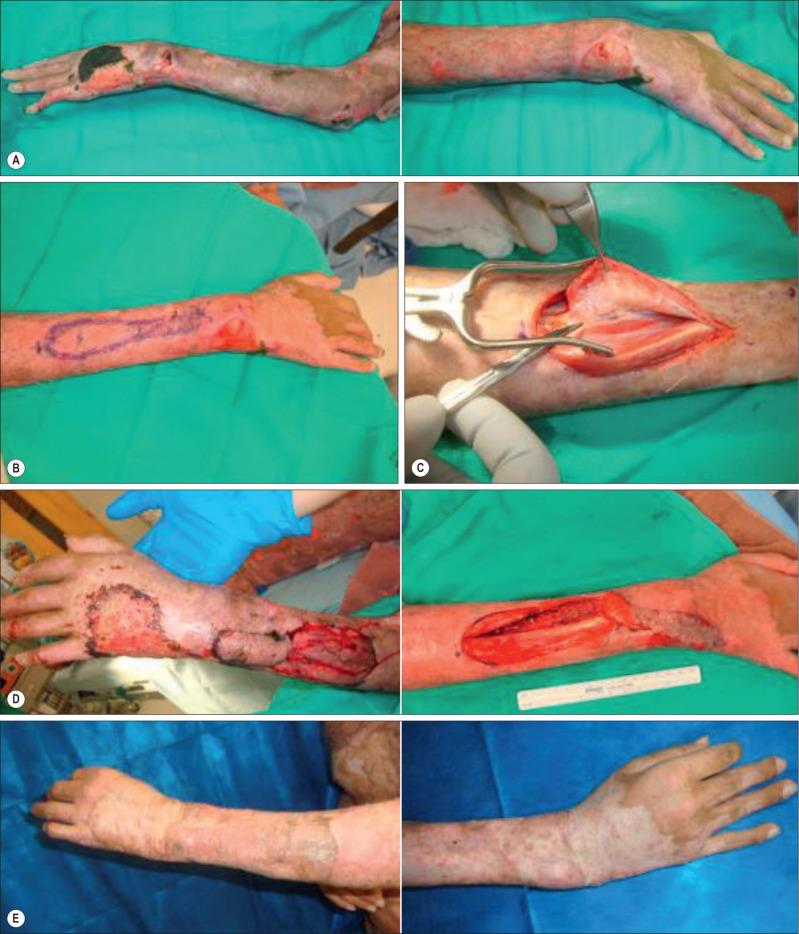
Management of burns to the palm is most often expectant. The thick glabrous skin of the palm has deep reticular structures and appendages allowing skin regeneration with minimal sequelae in most burns. In the event that grafting is required, there is continuing controversy over the best graft source: STSG, full-thickness skin graft (FTSG), or medium-thickness glabrous skin graft (MTGSG). Herndon et al. reported that STSG functions as well as FTSG for palm burns. Conversely Pham et al. have demonstrated that FTSG performed better for palm burns in children. MTGSG is the best tissue match, with good graft take and low donor site morbidity. In a 12-year experience with MTGSG, good sensation, color, and donor healing were reported. Plantar glabrous skin also transfers Meissner's corpuscles and sweat glands, structures that may be important to the fine sensation and grip needed on the palms. We tend to use STSG but the appropriate patient can find good utility in all of these techniques.
Active motion is the means by which the hand maintains plasticity. The burned hand is predisposed to fibrosis because skin grafts and scars contract and deform the hand, while pain, edema, dressings, and splints limit hand mobility. As such, daily OT and a close working relationship between the surgeon and the therapist are critical to functional outcomes, reducing the need for secondary reconstruction to as low as 3.7% at 9 years according to Kreamer and Deitch. A sufficient number of therapists should be available to treat each patient 1–2 times per day. A ratio of one therapist to seven patients is a good rule of thumb to allow for sufficient care. However the practicalities of early and aggressive OT are often limited by the particular practice scenario such as available personnel and other life-saving interventions, such as critical care or large burn wounds. Caring for hand burns requires extensive OT intervention and expertise in terms of physiotherapy and wound care usually only available at specialized centers.
The overall goals of OT are to maintain maximal hand movement, protect grafts, provide effective and well-fitting splints to maintain ligament length, and guide the patient's recovery toward maximum hand function. Intrinsic-plus splinting maximizes ligament and skin stretch in the position of function. The implication that the hand is safe in this position ignores the fact that the best position for the hand is in motion. No splinting should be considered as a resting substitute for active ROM.
OT can perform full ROM of all hand joints in the operating room prior to grafting to establish maximal mobility without pain and allowing the OT to be far more aggressive and expedient. This intervention can occur in parallel with other aspects of an operation thereby not increasing operative time. When fibrin glue or sutures are used to secure a sheet graft, therapists can take down the dressing on postoperative day 1, evaluate the graft, and evacuate any hematoma or seromas. If the graft is adherent to the wound bed, composite fist therapy should be initiated. Grafts are then dressed with functional compressive dressing and intrinsic-plus thermoplastic splints worn at night. Full range of hand motion can be achieved in 5 days with this protocol. Finally compression gloves should be manufactured to limit edema, hypertrophic scarring, and shearing of grafts.
Mobilization of the elbow is critical, and this joint should be kept extended to maintain maximal ligament length. Extension, however, is not a position of function, and, as such, elbow contractures in extension are debilitating because the patient is unable to reach hand to mouth. Therefore elbow ROM exercises are critical. The shoulder is similarly best splinted in abduction to prevent axillary contractures. However abduction is not a position of function, and ROM therapy is again critical.
Long-term hand deformities can develop and cause progressive deformities and disabilities despite aggressive acute care. As discussed earlier, the best option to avoid reconstruction is assiduous acute care. Early excision and grafting of hand burns within 4–6 days of injury gives a fivefold reduction in the need for secondary correction of scars or of being debilitated. When deformities occur refractory to OT, early reconstruction is advocated. It is critical that both the surgeon and the patient have realistic expectations of the reconstruction and acknowledge that full premorbid restoration of hand function can rarely, if ever, be accomplished.
The most common pathophysiology of burn deformity is insufficient skin coverage from scar contracture. This primary skin contracture limits or deforms hand movement and leads to a fibrosis of the tendinous and ligamentous structures of the hand with progressive loss of function. Early establishment of durable, flexible, and sufficient soft tissue coverage is critical to preventive and secondary treatment of these deformities. Chronic wounds also occur commonly and require operative excision and closure. The loss of structures such as digits or extensor tendons is also common, and a reconstructive balance needs to be struck between the desire for definitive reconstruction and the patient's tolerance for additional surgery.
It is important when reconstructing the hand to use the “reconstructive elevator” to determine the best solution for the patient and not move in a stepwise fashion through inadequate treatments. First, the contracture is incised or resected, the joints maximally stretched, and the entire extent of the tissue deficit made manifest ( Fig. 54.6 ).
Primary closure of the wound : This technique is used to close a wound resulting from the excision of hypertrophic scar tissues. Primary closure should only be considered when adjacent skin permits tension-free, nondeforming repair.
Grafting of a wound : In situations where a skin contracture has occurred, if the contracture can be released leaving an adequate bed for additional skin grafts, then either STSG or FTSG can be considered a sufficient skin envelope.
Skin flaps : Often an adequate bed cannot be established for a skin graft because critical structures need to be covered or the recurrence of skin graft contracture is a major concern. In these cases a random pattern skin flap can be designed to close the wound. Classic flap designs, including z-plasty, modified three-quarters z-plasty transposition flap technique, rhomboids, rotations, and advancements, are all reasonable choices in the circumstances when adjacent tissue can be used for a flap ( Fig. 54.7 ). The operating surgeon should not feel constrained to one type of tissue rearrangement and should choose the best surgery based on the defect and available adjacent tissue.
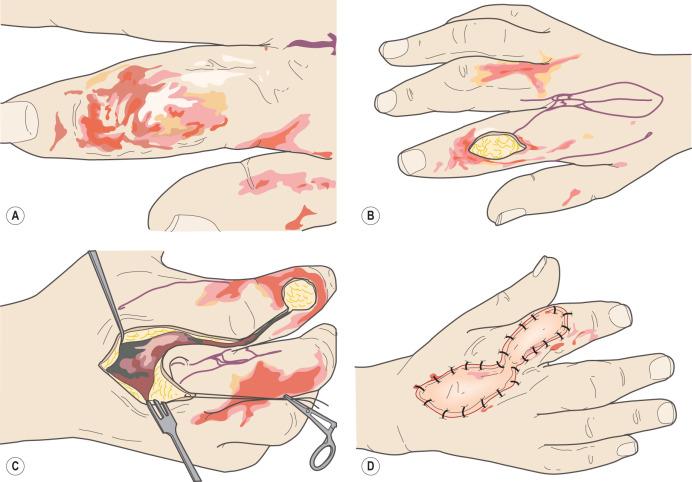
Muscle flaps, musculocutaneous (MC) flaps, and fasciocutaneous (FC) flaps : The vascular supplies to skin flap skin are enhanced by incorporating the muscle, fascia, or paratenon. The flap is mobilized to fill a defect resulting from scar release as a local, regional, or distant microsurgical flap (Fig. 57.16). In many cases early microsurgical reconstruction allows the best and most efficacious coverage of the wound and should be part of the armamentarium of surgeons treating these injuries. Muscle flaps bring a viable muscle to cover a wound, and the flaps themselves are covered with STSG (e.g., rectus flap). Musculocutaneous flaps bring a vascularized muscle with its overlying skin to cover a wound (e.g., latissimus dorsi flap). Fasciocutaneous flaps bring vascularized fascia with overlying skin to cover a defect (e.g., radial artery flap). Fascial flaps bring viable fascia and are subsequently covered with STSG (e.g., temporoparietal fascia flap). The best reconstruction technique depends on the patient's available donor tissue areas and overall health and tolerance for reconstruction and should not be constrained by the surgeon's technical ability or knowledge. Regardless of the tissue donor chosen, care must be taken to limit bulk and allow the patient to move the intricate joints of the hand freely.
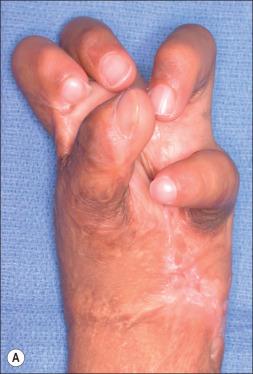
Become a Clinical Tree membership for Full access and enjoy Unlimited articles
If you are a member. Log in here